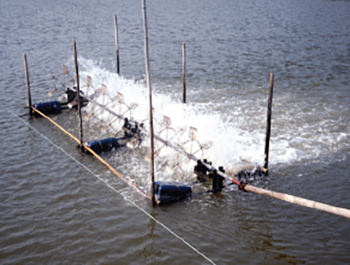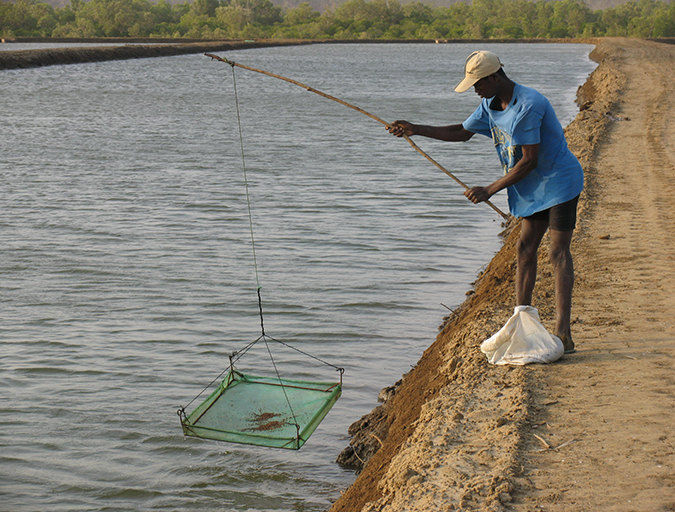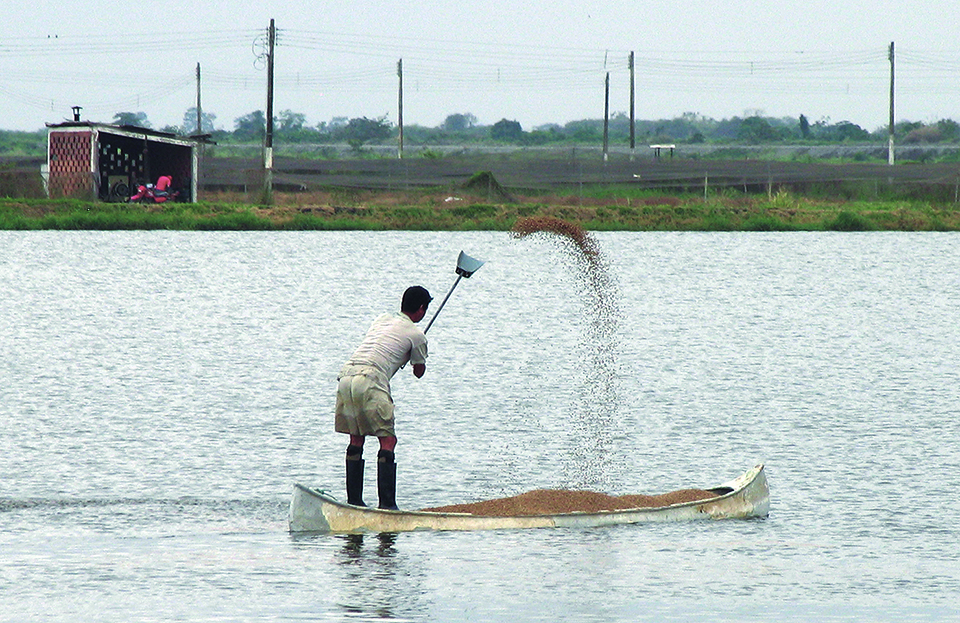Accuracy, reliability, repeatability of results critical for timely management decisions

Water analysis is becoming common in production aquaculture. At many production facilities, managers measure a variety of water quality variables such as water temperature, salinity, dissolved oxygen, alkalinity, hardness, dissolved phosphorus, total ammonia nitrogen, and nitrite. Increasing attention to conditions in culture systems is an indication of a greater awareness of the importance of water quality in aquaculture and of a desire to improve management.
Most facilities do not have a water quality laboratory or an individual trained in water analysis methodology to make analyses. Rather, they purchase water analysis meters and kits, and the individual chosen to make the analyses follows instructions provided with the meters and kits.
Results of water analyses are not useful and possibly detrimental in management decisions unless they are relatively accurate. Management decisions typically do not require results of as great an accuracy as sought in many applications of analytical chemistry. For example, knowing the pH within ± 0.2 units, total ammonia nitrogen within ± 0.2 mg/L, dissolved oxygen within ± 0.5 mg/L, and alkalinity and hardness within ± 5 mg/L of the true value usually will suffice in aquaculture.
Several brands of water analysis kits that use small, digital pH meters, digital titrators, and small electronic colorimeters can achieve the desired degree of accuracy needed in aquaculture. Water quality test kits that rely on titrations done by counting drops of titrating solutions and measuring color changes on test strips or comparing colors with a color wheel cannot be relied upon for suitable accuracy.
Achieving accurate, reliable results
A facility may have reliable water analysis meters and kits, and the analyst may follow instructions carefully. Nevertheless, it cannot be assumed that accurate and reliable results will be achieved. The acquisition of accurate and reliable results depends upon several conditions as follows: the sample must represent conditions to which culture animals are exposed; the sample must not change in concentrations of the variables of interest between sampling and analysis; errors made by the analyst must be no greater than normal analytical errors expected for the analysis.
The first condition can be met if the sample is collected from the location (with respect to both areal position and depth) where the culture species is located. Of course, some variables may be used in generalized treatments of culture systems. For example, alkalinity and hardness often are measured for determining the need for liming, and the focus is more on the entire culture system. For this purpose, several samples should be taken and either combined into a single sample for analysis or analyzed individually and the results averaged.
Compliance with the second condition requires the samples to be analyzed as quickly as possible. The most appropriate way of analyzing temperature, pH, and dissolved oxygen is to use an electronic meter that provides an immediate in situ result. Samples for salinity, alkalinity, hardness and other stable constituents on the other hand, can be placed in capped bottles and held for several days without fear of significant changes in concentrations of the variables. Samples for metabolically active variables such as nitrogen and phosphorus compounds should be analyzed as quickly as possible, but storage for up to 4 to 6 hr. usually is acceptable if samples are held in an insulated chest on ice.
The third condition for accuracy and reliability depends upon errors in the determination not being greater than normal analytical error. This condition is not necessarily fulfilled by following exactly the instructions provided with the meter or kit used for the analysis. It also cannot be verified by observing that two or three replicate analyses of a sample provide similar results. Rather, some system of quality control must be used to verify that analytical results are accurate.
Need for quality control
Evidence of the need for quality control in aquaculture water analysis was clearly revealed in a recent study by one of my graduate students (Benjaporn Somridhivej). She prepared standard alkalinity solutions of 20, 80, and 240 mg/L and sent them to 20 individuals or laboratories that make alkalinity measurements upon request — usually for aquaculture application. The analysts were asked to do three replicates of each sample, the results of which agreed very closely in all instances. However, the averages of the replicate analyses usually did not agree well with the concentrations of the standards. The results ranged from 6 mg/L to 35 mg/L for the 20 mg/L standard, from 22 mg/L to 107 mg/L for the 80 mg/L standard, and from 65 to 297 mg/L for the 240 mg/L standard.
Importance of repeatability
It is important to understand that repeatability (or precision) among the results of the replicate analyses of individual samples does not assure closeness to the true concentration (or accuracy). Many of those conducting water analyses for aquaculture apparently assume that precise results are accurate results. This is not necessarily true. Reagents — especially titrating solutions — used in a procedure may have changed in concentration during storage, instruments used in analyses may not have been calibrated properly or have lost their calibration, and some other water quality variable in the sample may have interfered with the measurement. Also, titrating solutions of different strengths are available for use with samples of different expected concentrations. It is possible without noticing to purchase a titrating solution of the incorrect strength, or to select from the shelf a titrating solution of the incorrect strength. In any of the situations mentioned above, replicate analyses of the same sample done by proper technique would give similar results (good precision), but the results — despite being precise — would not be accurate.

Application of proper techniques with the right equipment and reagents is another key component of proper water quality analysis.
Most vendors of water analysis kits sell standard solutions for use in verifying the accuracy of pH, salinity, alkalinity, hardness, phosphorus, ammonia nitrogen, and nitrate analyses. If analyses of standards reveal inaccuracies, the analyst must check all aspects of the procedure to identify and correct the source of error.=
Dissolved oxygen standards cannot be maintained in a reagent bottle. A sample of freshwater — distilled water preferably — can be thoroughly agitated in an open container for about 10 min to assure that it is saturated with dissolved oxygen. The oxygen saturation concentration in the water can be estimated for the altitude and water temperature by aid of a dissolved oxygen solubility table (available online). An accurate dissolved oxygen meter will read near the saturation concentration. Further verification of the dissolved oxygen meter can be made by boiling water for a few minutes and letting it cool quietly standing in a full, capped container. The meter should read zero dissolved oxygen in this water.
I am not suggesting that precision is unimportant. An analyst should be able to obtain similar results for repeated analyses of the same sample, but precision can be verified by occasional duplicate analyses. It is more important to verify the accuracy of analyses by frequent verification of the analyst’s ability to measure the concentration of a standard and obtain a measured value similar to the known value. Of course, standards should be replaced with new solutions at intervals.
Author
-

Claude E. Boyd, Ph.D.
School of Fisheries, Aquaculture and Aquatic Sciences
Auburn University
Auburn, AL 36830 USA
Tagged With
Related Posts

Responsibility
Efficiency of mechanical aeration
Although relatively expensive, mechanical aeration increases production. Asian-style paddlewheel aerators are widely used but are inefficient. Testing has led to more efficient designs that are now widely used in U.S. catfish and shrimp ponds.

Health & Welfare
Decomposition and accumulation of organic matter in ponds
Aquaculture ponds accumulate organic matter from organic fertilizer, remains of microorganisms produced within the pond, feces of the culture animals and uneaten feed. Claude E. Boyd, Ph.D., details the leading organic matter management practices, and says that the accumulation of organic matter is often not as great as believed.

Intelligence
An engineer’s design for a classroom aquaculture-aquaponics system
An aquaponics teaching system was designed, built and operated by students at the University of Arizona, integrating its operation and management into the educational curriculum. This engineering design will require minimum maintenance and will last years.

Aquafeeds
Aquaculture feed composition helps define potential for water pollution
A study found that feed for salmon and trout had higher organic carbon concentrations than did catfish, shrimp and tilapia feeds. Nitrogen and phosphorus concentrations were similar among salmon, trout and shrimp feeds, and higher than those in catfish and tilapia feeds.

